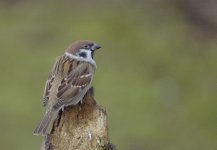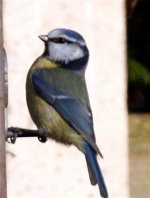gmax said:
Hi Paul,
I think these are the suggestions that might prove most helpful for a newbie (like me) ... perhaps a thread dedicated (sticky?) to these aspects would be warmly welcomed by most of us ...
En passant, do you think these settings might be applied as well to my 350D+Tamron 200-500?
Thank you,
Max
Hi Max,
Somewhere on another thread Keith Reeder proposed a 'sticky thread' on basic camera advice and settings so maybe we should get that going.
Anyway, yes I think those settings are relevant but instead of just saying use them I'll try to explain why they are a good starting point.
A proviso I will mention straight away is that some of the settings were for using the camera in the near darkness that passes for daytime in England at the moment! In Italy the light may well be better and that will be in your favour as some settings can be altered, which I will come onto.
Aperture priority. using this setting gives the easiest control over the shutter speed which is essential. The auto mode and the P mode mean the camera sets what it wants - not good, I'll skip Tv and manual mode because life's too short.
By setting Av and then turning the dial to the lenses widest aperture, F5.6 (as it reports it to the camera, its actually F6.3 but don't worry about that) the camera will set the fastest shutter speed it can for the amount of light.
In my opinion this is essential because for people new to using this sort of kit camera shake is the biggest factor in ruined pictures.
The ISO setting also affects the shutter speed, the higher the ISO the higher the shutter speed - good news. The bad news is that the image quality deteriorates at high ISO's. So ISO400 is a good compromise to keep the shutter speed high but also keep good image quality.
With these settings applied you can now see what shutter speed the camera has set. If you are handholding the lens I still say (although I was shot down on this before) it NEEDS to be at least 1/500 of a second. If the lens is supported then it can be lower.
If, say, the shutter speed is 1/250 you will have to increase the ISO to 800 and sort out the noise in the image later. If its 1/125 increase the ISO to 1600. If its below that and you need to handhold don't bother.
If, in sunny Italy, the shutter speed is 1/4000 you can increase the aperture to F7.1 and decrease the ISO to 200. The shutter speed will still be above 1/500 and the changed settings will improve the picture quality, Lenses work better whats called 'stopped down' a bit from their maximum aperture.
I use centre weighted metering because I find evaluative tends to expose for the background rather than the bird and partial alters the settings wildly. To explain beyond that is I think complicating things at the moment.
A1Servo. This focus mode 'tracks' the bird as it moves and so gives the best chance of having the bird in focus when you press the shutter.
These settings should give you a chance of a decent shot. Exposure problems will raise their head but I think are less important in the early days than getting a sharp, focussed image.
Under and overexposed images can, to a degree, be sorted out later but a blurred image is blurred. Full Stop.
And above all else take lots of shots and get used to the 'feel' of the kit.
Hope that helps
Paul






